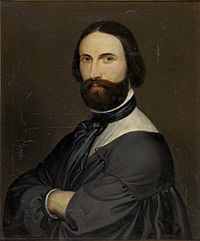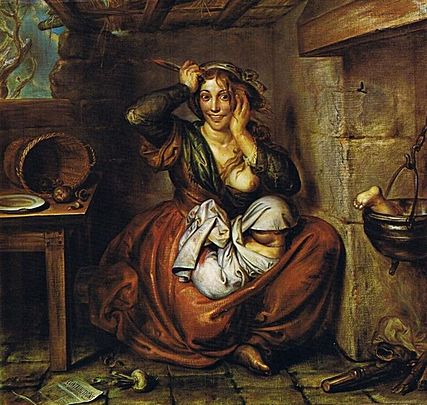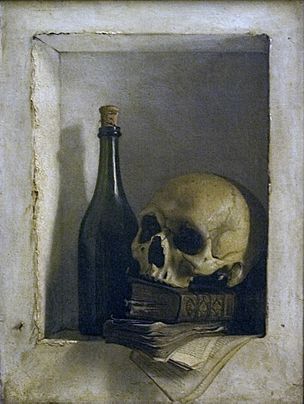Antoine Wiertz facts for kids
Quick facts for kids
Antoine Wiertz
|
|
|---|---|

Self-portrait of the artist in his studio attire, c. 1855
|
|
| Born | 22 February 1806 |
| Died | 18 June 1865 (aged 59) |
| Nationality | Belgian |
| Known for | Painting |
| Movement | Romanticism, Realism, Symbolism |
Antoine Joseph Wiertz (born February 22, 1806 – died June 18, 1865) was a Belgian artist. He was a painter, sculptor, and writer about art. He is famous for his religious, historical, and symbolic paintings, as well as his portraits.
Wiertz was a unique artist. He was greatly inspired by famous painters like Rubens and Michelangelo. Some of his artworks are quite dark and mysterious. They even hint at a later art style called Symbolism. Even though art critics at the time didn't always like his work, the new Belgian government supported him. They helped him build his own studio and home in Brussels, which is now the Wiertz Museum. He worked there quietly on his art and writings.
Contents
Becoming an Artist: Antoine Wiertz's Early Life
Antoine Wiertz was born in Dinant, a town in Belgium. His father, Louis-François Wiertz, was a soldier for Napoleon I. Later, he became a police officer. His father encouraged Antoine to dream big and become a great person. From a young age, Antoine showed a natural talent for drawing, making models, and carving wood.
Discovering His Talent
A local politician named Paul de Maibe noticed young Antoine's artistic skills. De Maibe owned ironworks in Dinant. He took Antoine under his wing and helped him. In 1820, when Antoine was just 14, de Maibe helped him get into the Antwerp art academy.
Thanks to de Maibe, King William I of the Netherlands gave Antoine money every year starting in 1821. At the academy, Antoine's teachers, Mattheus Ignatius van Bree and Willem Jacob Herreyns, encouraged his love for Flemish painting. They especially liked the work of Peter Paul Rubens. Herreyns was actually one of the last artists to follow Rubens' style. Rubens' art became a huge inspiration for Wiertz.
Studying in Europe
In 1828, Wiertz came in second place for a major art award called the Prix de Rome. From 1829 to 1832, he lived in Paris. He earned money by painting portraits. He studied old master paintings at the Louvre museum. He loved Rubens' work there. However, he didn't like the modern French artists of his time.
After Belgium became independent, Wiertz won the first Belgian Prix de Rome in 1832. The prize money, 10,000 francs, allowed him to travel to Rome to continue his studies. He joined the French Academy at Rome and lived there from 1834 to 1837. When he returned, he settled in Liège with his mother.
While in Rome, Wiertz worked on his first big painting. It was called "Greeks and Trojans fighting for the body of Patroclus". He finished it in 1836. People in Rome admired it, and it was shown in Antwerp in 1837, where it was quite popular. Wiertz sent the painting to the Paris Salon (a famous art exhibition) in 1838, but it arrived too late.
Antoine Wiertz's Main Artworks
At the Paris Salon in 1839, Wiertz showed his "Patrocles" painting. He also showed three other works: Madame Laetitia Bonaparte on her deathbed, The fable of the three wishes — Man's insatiability, and Christ entombed. His paintings were not displayed well and didn't get much attention from the public. Critics were even sarcastic about them.
Facing Criticism and Creating Big Art
This bad experience in Paris in 1839 made Wiertz very angry at art critics and at Paris itself. He even wrote a strong pamphlet (a short book) called Bruxelles capitale, Paris province. In 1844, Wiertz painted a second, even larger version of his "Patrocles" painting. The first version from 1836 is now in the Museum of Walloon Art in Liège. The 1844 version is in the Wiertz Museum in Brussels.
After the Paris exhibition, Wiertz's art became more and more dramatic. A good example is his huge painting, The Fall of the rebellious Angels, from 1841. It is painted on a curved canvas and is very large. He started to get recognition in Belgium. He was even made a Knight of the Order of Leopold.
Personal Struggles and New Techniques
His mother's death in 1844 was very hard for Wiertz. He left Liège in 1845 and moved to Brussels for good. During this time, he painted a famous work called Two young girls (The beautiful Rosine) (1847). It shows a meeting between Beauty and Death. This painting is still one of his most well-known works.
Wiertz wasn't happy with how shiny oil paint looked, especially on large canvases. He created a new painting method. It combined the smooth look of oil painting with the quickness and dull finish of fresco painting (painting on wet plaster). This "mat painting" technique used a mix of colors, turpentine, and petrol on canvas. The Homeric battle (1853) was the first large painting he made using this method.
However, the chemicals he used in this technique caused his artworks to slowly decay. This has affected how people view his art today. The use of these chemicals might also have caused Wiertz to get sick and die at a younger age.
Wiertz was also a skilled portrait painter. He painted many self-portraits at different times in his life. As a sculptor, his most important project was a series of plaster sculptures. They showed The Four Ages of Man (1860–1862). These were later made into marble for the Wiertz Museum.
Wiertz's large paintings were mainly influenced by Peter Paul Rubens and the later works of Michelangelo. His art often mixes classic academic style with intense romanticism. It can be grand but also a bit strange. Even though some people called his work art pompier (a term for overly dramatic art), his style actually hinted at Symbolism and Surrealism. These art movements later became very important in Belgian painting.
Antoine Wiertz's Later Life and Legacy
After some talks with the Belgian government, Wiertz achieved his dream. He wanted his last studio to become a museum for his artworks. The Belgian government bought land and paid for a huge hall to be built. This hall was big enough for his giant paintings. In return, Wiertz gave all his artworks to the Belgian government. He made sure they would stay in his studio both during his life and after he passed away.
Wiertz died in his studio. His body was prepared using ancient Egyptian methods. He was buried in a special vault in the cemetery of Ixelles.
A copy of one of Antoine Wiertz's sculptures, The Triumph of Light, was once placed high up on Mount Olympus in San Francisco. A man named Adolph Sutro gave it to the city in 1887. Over the years, the statue was not taken care of and fell apart. By the 1950s, the statue had disappeared completely. Today, only the base of the monument remains.
Gallery
Wiertz Museum
The Antoine Wiertz Museum is now part of the Royal Museums of Fine Arts of Belgium. You can find it at 62, rue Vautier/Vautierstraat in Ixelles. This area is in the middle of the Leopold Quarter, close to the Brussels-Luxembourg railway station. A street called Rue Wiertz runs from the museum through the European Parliament complex. This is a cool coincidence, as Wiertz himself wanted Brussels to be a major capital.
See also
 In Spanish: Antoine Wiertz para niños
In Spanish: Antoine Wiertz para niños




